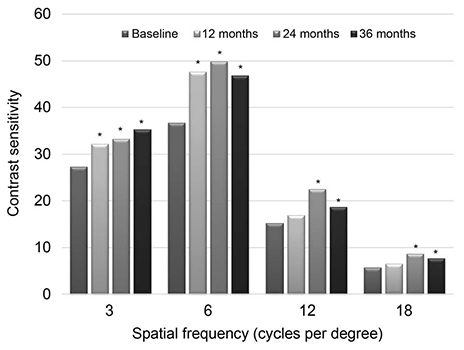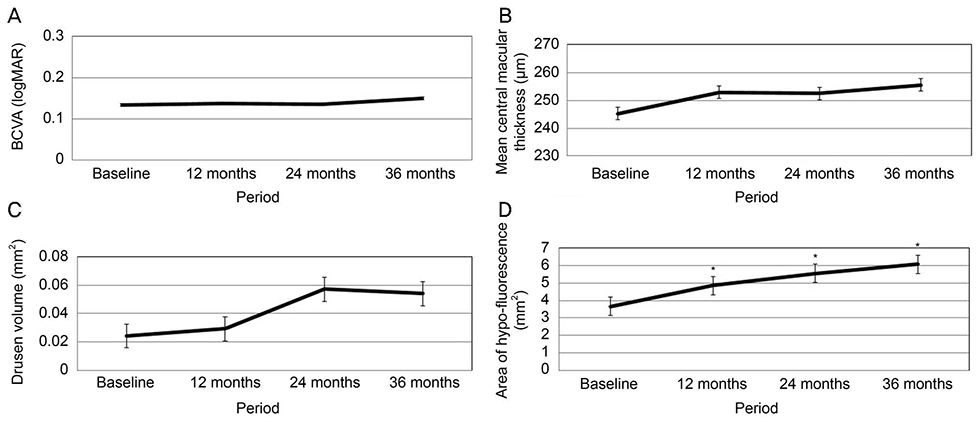J Korean Ophthalmol Soc.
2018 Dec;59(12):1152-1159. 10.3341/jkos.2018.59.12.1152.
Long-term Results of Taking Anti-oxidant Nutritional Supplement in Intermediate Age-related Macular Degeneration
- Affiliations
-
- 1Department of Ophthalmology, Kyung Hee University Hospital, Kyung Hee University College of Medicine, Seoul, Korea. syyu@khu.ac.kr
- 2Department of Ophthalmology, Kim's Eye Hospital, Konyang University College of Medicine, Seoul, Korea.
- 3Department of Ophthalmology, Kyungpook National University School of Medicine, Daegu, Korea.
- 4Department of Ophthalmology, Pusan National University School of Medicine, Yangsan, Korea.
- 5Department of Ophthalmology, Seoul National University College of Medicine, Seoul, Korea.
- 6Blue Eye Center, Seoul, Korea.
- KMID: 2428687
- DOI: http://doi.org/10.3341/jkos.2018.59.12.1152
Abstract
- PURPOSE
We prospectively investigated clinical changes and long-term outcomes after administration of the drugs recommended by the Age-Related Eye Disease Study-2 to patients with intermediate age-related macular degeneration (AMD).
METHODS
This prospective multicenter study enrolled 79 eyes of 55 patients taking lutein and zeaxanthin. The primary endpoint was contrast sensitivity; this was checked every 12 months for a total of 36 months after treatment commenced. The secondary endpoints were visual acuity, central macular thickness, and drusen volume; the latter two parameters were assessed using spectral domain optical coherence tomography.
RESULTS
The mean patient age was 72.46 ± 7.16 years. Contrast sensitivity gradually improved at both three and six cycles per degree. The corrected visual acuity was 0.13 ± 0.14 logMAR and did not change significantly over the 36 months. Neither the central macular thickness nor drusen volume changed significantly.
CONCLUSIONS
Contrast sensitivity markedly improved after treatment, improving vision and patient satisfaction. Visual acuity, central retinal thickness, and drusen volume did not deteriorate. Therefore, progression of AMD and visual function deterioration were halted.
Keyword
MeSH Terms
Figure
Reference
-
1. Vingerling JR, Dielemans I, Hofman A, et al. The prevalence of age-related maculopathy in the Rotterdam study. Ophthalmology. 1995; 102:205–210.
Article2. Klein R, Chou CF, Klein BE, et al. Prevalence of age-related macular degeneration in the US population. Arch Ophthalmol. 2011; 129:75–80.
Article3. Klein R, Klein BE, Linton KL. Prevalence of age-related maculopathy. The beaver dam eye study. Ophthalmology. 1992; 99:933–943.4. Krishnaiah S, Das TP, Kovai V, Rao GN. Associated factors for Age-related maculopathy in the adult population in southern India: the Andhra Pradesh eye disease study. Br J Ophthalmol. 2009; 93:1146–1150.
Article5. Miyazaki M, Nakamura H, Kubo M, et al. Risk factors for age related maculopathy in a Japanese population: the Hisayama study. Br J Ophthalmol. 2003; 87:469–472.
Article6. Song SJ, Youm DJ, Chang Y, Yu HG. Age-related macular degeneration in a screened South Korean population: prevalence, risk factors, and subtypes. Ophthalmic Epidemiol. 2009; 16:304–310.
Article7. Park SJ, Lee JH, Woo SJ, et al. Epidemiologic Survey Committee of the Korean Ophthalmologic Society; Age-related macular degeneration: prevalence and risk factors from Korean National Health and Nutrition Examination Survey, 2008 through 2011. Ophthalmology. 2014; 121:1756–1765.8. Dimitrov PN, Mukesh BN, McCarty CA, Taylor HR. Five-year incidence of bilateral cause-specific visual impairment in the Melbourne visual impairment project. Invest Ophthalmol Vis Sci. 2003; 44:5075–5081.
Article9. Domalpally A, Danis R, Agrón E, et al. Evaluation of geographic atrophy from color photographs and fundus autofluorescence images: age-related eye disease study 2 report number 11. Ophthalmology. 2016; 123:2401–2407.10. Ding X, Patel M, Chan CC. Molecular pathology of age-related macular degeneration. Prog Retin Eye Res. 2009; 28:1–18.
Article11. Age-Related Eye Disease Study Research Group. A randomized, placebo-controlled, clinical trial of high-dose supplementation with vitamins C and E, beta carotene, and zinc for age-related macular degeneration and vision loss: AREDS report no. 8. Arch Ophthalmol. 2001; 119:1417–1436.12. Faria BM, Duman F, Zheng CX, et al. Evaluating contrast sensitivity in age-related macular degeneration using a novel computer-based test, the SPAETH/RICHMAN contrast sensitivity test. Retina. 2015; 35:1465–1473.
Article13. Maynard ML, Zele AJ, Feigl B. Mesopic Pelli-Robson contrast sensitivity and MP-1 microperimetry in healthy ageing and age-related macular degeneration. Acta Ophthalmol. 2016; 94:e772–e778.
Article14. Richman J, Spaeth GL, Wirostko B. Contrast sensitivity basics and a critique of currently available tests. J Cataract Refract Surg. 2013; 39:1100–1106.
Article15. Hammond BR, Fletcher LM, Roos F, et al. A double-blind, placebo-controlled study on the effects of lutein and zeaxanthin on photostress recovery, glare disability, and chromatic contrast. Invest Ophthalmol Vis Sci. 2014; 55:8583–8589.
Article16. Nolan JM, Power R, Stringham J, et al. Enrichment of macular pigment enhances contrast sensitivity in subjects free of retinal disease: central retinal enrichment supplementation trials - report 1. Invest Ophthalmol Vis Sci. 2016; 57:3429–3439.
Article17. Kvansakul J, Rodriguez-Carmona M, Edgar DF, et al. Supplementation with the carotenoids lutein or zeaxanthin improves human visual performance. Ophthalmic Physiol Opt. 2006; 26:362–371.
Article18. Loughman J, Nolan JM, Howard AN, et al. The impact of macular pigment augmentation on visual performance using different carotenoid formulations. Invest Ophthalmol Vis Sci. 2012; 53:7871–7880.
Article19. Nolan JM, Loughman J, Akkali MC, et al. The impact of macular pigment augmentation on visual performance in normal subjects: COMPASS. Vision Res. 2011; 51:459–469.
Article20. Olmedilla B, Granado F, Blanco I, Vaquero M. Lutein, but not alpha-tocopherol, supplementation improves visual function in patients with age-related cataracts: a 2-y double-blind, placebo-controlled pilot study. Nutrition. 2003; 19:21–24.21. Ma L, Lin XM, Zou ZY, et al. A 12-week lutein supplementation improves visual function in Chinese people with long-term computer display light exposure. Br J Nutr. 2009; 102:186–190.
Article22. Bartlett HE, Eperjesi F. Effect of lutein and antioxidant dietary supplementation on contrast sensitivity in age-related macular disease: a randomized controlled trial. Eur J Clin Nutr. 2007; 61:1121–1127.
Article23. Woods RL, Wood JM. The role of contrast sensitivity charts and contrast letter charts in clinical practice. Clin Exp Optom. 1995; 78:43–57.
Article24. Legge GE, Rubin GS, Pelli DG, Schleske MM. Psychophysics of reading--II. Low vision. Vision Res. 1985; 25:253–265.
Article25. Lovie-Kitchin JE, Mainstone JC, Robinson J, Brown B. What areas of the visual field are important for mobility in low vision patients. Vision Res. 1990; 5:249–263.
- Full Text Links
- Actions
-
Cited
- CITED
-
- Close
- Share
- Similar articles
-
- The Review on Nutritional Supplements in Age-Related Macular Degeneration
- Survey of AREDS2 Formula Intake in Korean Patients with Age-related Macular Degeneration
- Nutritional supplement for age-related macular degeneration
- Compliance with the Recommended Age-related Eye Disease Study 2 Supplementation among Korean Age-related Macular Degeneration Patients
- Detection of Subclinical Non-Exudative Choroidal Neovascularization in Patients with Intermediate Age-related Macular Degeneration




